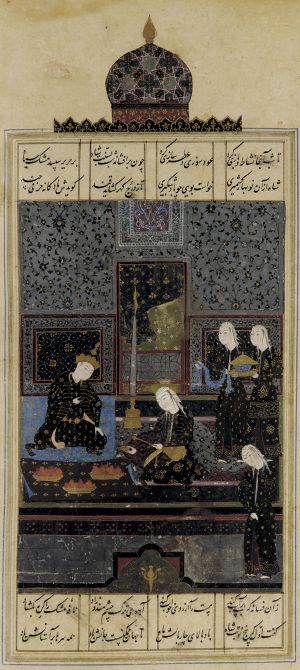User:Ayatollah Gurkhmeini/Sandbox
iRan 'ايران' Iran | |||||
|---|---|---|---|---|---|
| |||||
| Motto: 'Marg Bar Amrika!' | |||||
| Anthem: I Ran | |||||
 | |||||
| Capital | Tehran | ||||
| Largest city | Tehran | ||||
| Official language(s) | |||||
| Government | Theocracy | ||||
| Ali Khamenei | |||||
| ‑ | Mahmoud Ahmadinejad | ||||
| National Hero(es) | Cyrus, Darius, Imam Khomeini | ||||
| Declaration of Independence | 1979 | ||||
| Currency | severed hands | ||||
| Religion | Terror, Fear | ||||
| Major exports | Terror, hate, asylum-seekers, oil | ||||
| Major imports | Non-fire retardant U.S. flags, uranium | ||||
Iran (ايران), officially the Islamic Republic of iRan, formerly known internationally as Los Angeles, is a country in central Eurasia known for its temperate climate, congenial people, and despotic government. Tehran is the capital, the country's largest city and the political, cultural, commercial, and industrial center of the nation. In addition, it is the only place you will get laid. Iran is a regional power, and occupies an important position in international energy security and world economy as a result of its large reserves of petroleum, natural gas, and hot air.
Geography[edit | edit source]
Iran consists of the Iranian Plateau with the exception of the coasts of the Caspian Sea and Khuzestan. It is one of the world's most mountainous countries, its landscape dominated by rugged mountain ranges that separate various basins or plateaus from one another. In addition, it is well-endowed with oil and due to complex geological phenomena, has no homosexuals. Basically, it is like the Western United States, only with Baptists and Mormons replaced with Shi'a Muslims and cowboy poets replaced with Rumi.
The populous western part is the most mountainous, with ranges such as the Caucasus, Zagros and Alborz Mountains. Much like the West's California, it is the only part of the country with any culture. The Northern part of Iran is covered by dense rain forests called the Jungles of Iran, populated primarily by hipsters and geeks, much like the Pacific Northwest. The eastern part consists mostly of desert basins such as the Dasht-e Kavir, Iran's largest desert, in the north-central portion of the country, and the Dasht-e Lut, in the east, as well as some salt lakes, sort of like Utah but somewhat less religious. This is because the mountain ranges are too high for non-peer-reviewed BYU researchers to reach these regions.
Iran's climate ranges from semiarid to arid to unbearably arid. Much like Colorado, Iran is heir to both severe winters and unlivable summers, with most of the water coming from mountain reservoirs. The analogy falls apart though, when applied to the cultural geography of the region, as most Iranian mullahs have far more nuanced readings of scripture than most Coloradoans and are far less prone to violence.
Provinces and Cities[edit | edit source]
Iran has one of the highest urban-growth rates in the world, primarily because Persians are so damn sexy. If an Iranian male and non-veiled Iranian female are left together in the same room for thirty minutes, they will produce at least seven children during the short period. From 1950 to 2002 the urban proportion of the population increased from 27% to 60%. The United Nations predicts that by 2030 80% of the population will be urban. Most internal migrants have settled near the cities of Los Angeles, Tehran, Isfahan, Ahvaz, and Qom. Tehran is home to around 11% of Iran's population. Tehran, like its Western hemisphere equivalent, Los Angeles, suffers from severe air pollution and problems with the Persian Mafia. It is the hub of the country's communication and transport network.
Qom, to the south of Tehran, is considered to be a holy city in Shi`a Islam. The city is the largest center for Shi'a scholarship in the world, and is a significant destination of pilgrimage. Much like Provo, Utah or Colorado Springs, Colorado, it is a center for religious scholarship and home of conservative politicans. Qom's proximity to Tehran, Iran's capital, has allowed the clerical establishment easy access to monitor the affairs and decisions of state, much like BYU professors making sure that the Utah state legislature doesn't decriminalize homosexuality.
Shiraz is known as the city of poets, wine and flowers, a sort of Iranian San Francisco, except instead of having a Gay Pride Parade every year, they have a mass-hanging of convicted sodomites. Tabriz, in northwestern Iran, is a center of technology and education and predominantly Azeri-speaking. During the early twentieth century, it was often the first city to adopt new Western technologies, and, as a result, the first city to recieve a fatwa from Qom denouncing the ills of the automobile or telephone. Mashhad, in Khorasan province, is the country's second-biggest city and a center of Shi'a pilgrimage due to some pretty building built to honor some dead guy who was a saint or something.
Isfahan, the capital of Iran under the Safavids, is famous as treasure-trove of Persian architecture, with many beautiful boulevards, covered bridges, gardens, palaces, mosques, and minarets. Today it is equally well-known as a center for uranium-enrichment and plutonium-weaponization.
Hamadan, in the conviniently-named Hamadan Province, was an ancient capital for the Achaemenids, Arsacids, and Sassanids and the world's oldest continuously-inhabited city. People you vaguely remember from world civ in junior high like Avicenna and Esther are buried there. Seriously, Hamadan is probably the most important city in the world.
History[edit | edit source]
Iran is home to one of the world's oldest continuous major civilizations, with historical and urban settlements dating back to 4000 BC. This is a fact all Persians are required to inform you of every time you talk to them. "While you were killing rabbits and putting them on trees because you thought the sun would go away," they will say, "we were busy inventing civilization." They are leaving out the fact that early Persian culture derived much from earlier Elamite and Sumerian civilizations and that they had their butts kicked by the Greeks and Arabs, but you get the jist of it. Iranians are just cocky like that.
Iran is but a part of the much larger cultural area called Irān-e Bozorg (ایران بزرگ). Because Persians are the only people in the world with any culture, many of Iran's neighbors decided to borrow civilization from Iran rather than develop a complex culture on par with Iran's. Weran was comprised of several states that are today their own independent nations. For example, all of the -stan countries at one time were just provinces of Iran rather than post-communist kleptocracies struggling to contain large Islamic insurgencies funded primarily by Iran.
Theyran was named that to mark and celebrate the running of the Greek soldiers from the advancing Persian army during the first Marathon run in 500 BC. The modern name for this celebrated city is Tehran.
Modern day Kuwait was known as Sheran and modern day Iraq was known as Rerun. Eventually, however, Weran was broken up in The Great Running War.
Twentieth Century History[edit | edit source]
In 1905 Reza Shah Pahlavi (aka. Khoda Beyamorzi) was forced by a broad coalition of clerics, merchants, and students to introduce broad reforms. Eventually, he buckled, and a new constitution was drafted. For some reason, it was modeled after the constitution of Belgium. This all changed, however, when in 1951 Prime Minister Mohammad Mossadegh led a democratic coup against the shah. After taking power, Mossadegh led a campaign of nationalistic reforms which culminating in the nationalization of the Anglo-Iranian oil company. Winston Churchill, who naturally had more claim to Iranian oil than Mossadegh due to the fact that he was white, convinced the US government that Mossadegh was a communist and therefore needed to be replaced with a dictator. The coup in Iran has proved to be the model for American policy for over fifty years.
Meanwhile, after being resurrected by the Devil himself, The Ayatollah, formerly known as Saruman the lord of Isengard, was given his new title (the Ayatollah) by the Devil, and was instructed to lead an evil revolution in Iran which resulted in millions fleeing the country. After a decade or so of evil doings in Iran, the Ayatollah was called back to the depths of hell by the Devil once again as he was creating too much competition for the Devil; He was quite frankly making the Devil look bad (less evil actually) by comparison.
In 1977, Iran played Tatooine in the film 'Star Wars'. After failing to win an Oscar for its performance, Iran became rabid with anger. This anger grew among the populace for several years, growing to the point that men in the country were taking out their rage on the women in their home and community. In 1979, disgruntled citizens underwent the Very Pissed Off And Rather Sexist Revolution. Iran's new leaders immediately ordered women to cover themselves with black sheets to hide their horrible bruises. It is worth noting that some historians have an alternate theory as to why the new regime demanded that woman cover themselves. Several key figures in the regime were transvestites, and according to these historians, they demanded that all women cover themselves in hopes that everyone in Iran would forget that real women don't have beards. The Persian national anthem is really gay.
In 1980, Iran went to war with Iraq, insisting that disgruntled employee Saddam 'Da Man' Hussein had changed the region's name from Iran to Iraq in order to steal some sand by pretending it was a whole other country. Eight years later, several million teenagers were dead, and no one had conquered the sand. The UN declared the sand the winner. This event was recently repeated by US and British forces attempting to steal the same expanse of sand, but the granulated earth has proved too resolute in the face of conflict. The U.S. attempt to conquer the sand, ironically, has given Iran much more political clout.
Iran in popular culture[edit | edit source]
- The Persian Empire appeared in the little disseminated graphic novel 300, where it was portrayed in a sympathetic light. A low budget independent film of the same name also featured the empire, though it showed at only three theatres worldwide.
- BBC News has jokingly described Rumi as the "most popular poet in America." It is widely known that Americans do not read, and instead choose to watch slasher movies and pornos.
- At the beginning of the Islamic Revolution, one of the popular performance artists in Iran, Sadeq Khalkhali, tried to destroy 2500-year-old ruins of Persepolis, and after that the mausoleum of Ferdowsi. This act was seen as an interesting take on post-modernism by the Western art establishment, as was his mass execution of political dissidents and apostates. Jeff Koons has called Khalkhali one of his major influences.
- In 1996, Supreme Leader Ali Khamenei issued a fatwa against music education. He also claims that "Beatle-ism" has ravaged Western youth and that the Persian language is pretty much crap.




